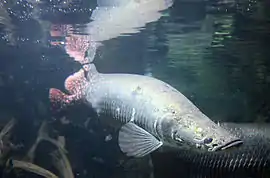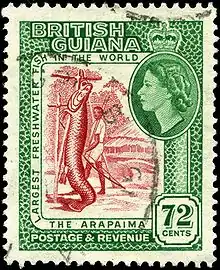Arapaima gigas
Arapaima gigas, also known as pirarucu,[2] is a species of arapaima native to the basin of the Amazon River. Once believed to be the sole species in the genus, it is among the largest freshwater fish. The species is an obligate air-breather and needs to come to the surface regularly to gulp air.
| Arapaima gigas | |
|---|---|
 | |
| Scientific classification | |
| Kingdom: | Animalia |
| Phylum: | Chordata |
| Class: | Actinopterygii |
| Order: | Osteoglossiformes |
| Family: | Arapaimidae |
| Genus: | Arapaima |
| Species: | A. gigas |
| Binomial name | |
| Arapaima gigas (Schinz, 1822) | |
| Synonyms | |
| |
Taxonomy
Arapaima gigas was originally regarded as the only species in the genus Arapaima, but the subsequent identification of further species, together with the rarity of specimens and the loss of several type specimens, has led to some uncertainty regarding classification within the genus and the identity of described individuals.[3]
Description
The species is among the largest known freshwater fish, commonly measuring 200 centimetres (79 in) and reportedly exceptionally reaching lengths of up to 450 centimetres (15 ft). Adults may weigh up to 200 kilograms or 440 pounds.[4] A. gigas has a streamlined body with dorsal and anal fins set well back towards the tail. While the body is mainly gray to gray-green, its Brazilian local name "pirarucu" derives from an indigenous word for "red fish", thought to refer to either the red flecks on the scales towards the tail, or the reddish-orange color of its meat.[2] The fish have "flexible armor-like scales" made up of "a hard mineralized outer layer" and "a tough-but-flexible inner layer" that help protect it from attacks by piranhas.[5]
Distribution
A. gigas is native to freshwater in the basin of the Amazon River; it is known to occur in Bolivia, Brazil, Colombia, Guyana and Peru.[4][1] In Bolivia, the paiche is considered an invasive species, affecting local native species and the ecosystem. It was first found in 1976[6] and presumably introduced from Peru being washed out of a Peruvian fish farm by a flood.[7] The species has been introduced to parts of East Asia, both for fishing purposes and accidentally.[2]
Fossils of arapaima (or very similar species) have been found in Colombia, in the Villavieja Formation, which dates from the Miocene era.[8]
Ecology
A. gigas has the capability to breathe surface air to supplement the oxygen it derives from the use of its gills, and indeed is dependent on surfacing every 5–15 minutes to loudly gulp air at the surface. As in other species in the genus, a modified swim bladder that contains lung-like tissue is used for this purpose.
The species primarily feeds on fish, although juveniles will prefer insects and fish larvae until fully grown. They will also consume birds, mammals, fruits and seeds on the water surface.[9]
Spawning occurs in lakes and river channels during the time of low water levels (August to March). After the young hatch from eggs laid in a nest constructed by both parents, the male remains to protect them for a period of about three months. The young reach sexual maturity at an age of four to five years; average life span in captivity is 15–20 years.[2]
Conservation
The species has in the past been heavily impacted by overfishing, exacerbated by their easily exploited habit of surfacing regularly for air-gulping. The IUCN is currently not assigning a conservation status to A. gigas due to a lack of detailed information about population developments.[2] Arapaima fishing was banned outright in Brazil from 1996 to 1999, due to declining populations; since then, both subsistence and commercial fishing have been permitted in specially designated areas, and a sophisticated sustainable management strategy has led to massive recovery of stocks, from 2,500 in 1999 to over 170,000 in 2017.[10]

For Bolivia, the paiche as an invasive species is itself considered a threat to local native species according to reports. There are various reports on a correlation between the spreading of paiche and the decline in numbers of native fish species in parts of the Bolivian amazon. Effects on local fish species populations and on fishing behaviors vary strongly by region.[7] A joint study of the Bolivian government and different research organizations from 2017 points out the necessity to further evaluate the complex environmental and socioeconomic impact of paiche in the country.[11]
References
- World Conservation Monitoring Centre (1996). "Arapaima gigas". IUCN Red List of Threatened Species. 1996: e.T1991A9110195.CS1 maint: uses authors parameter (link)
- "Arapaima (Arapaima gigas)". Arkive.org. Archived from the original on 2012-11-03. Retrieved 2017-05-29.
- Stewart, D. J. (2013). "Re-description of Arapaima agassizii (Valenciennes), a rare fish from Brazil (Osteoglossomorpha, Osteoglossidae)". Copeia. 2013: 38–51. doi:10.1643/ci-12-013.
- Froese, Rainer and Pauly, Daniel, eds. (2017). "Arapaima gigas" in FishBase. 5 2017 version.
- Dunham, Will (2019-10-16). "Amazon fish wears nature's 'bullet-proof vest' to thwart piranhas". Reuters. Retrieved 2019-10-18.
- La aventura del Paiche en la Amazonía de Bolivia, Laregion.bo. Retrieved 2020-02-27.
- Can We Really Eat Invasive Species into Submission?, Scientific American. Retrieved 2020-02-27.
- "A Miocene Fossil of the Amazonian Fish Arapaima (Teleostei, Arapaimidae) from the Magdalena River Region of Colombia - Biogeografic and Evolutionary Implications", by John G. Lundberg and Barry Chernoof, on Biotropica 24, 1992
- https://nationalzoo.si.edu/animals/arapaima
- Gonçalves ACT, Cunha J, Batista JS (2018). The Amazonian Giant: Sustainable Management of Arapaima (Pirarucu) (pdf). Tefé, Amazonas: Mamirauá Institute for Sustainable Development. ISBN 978-85-88758-77-3. Retrieved 2020-05-05.CS1 maint: multiple names: authors list (link)
- Bases técnicas para el manejo y aprovechamiento del paiche (Arapaima gigas) en la cuenca amazónica boliviana Archived 2020-02-27 at the Wayback Machine, faunagua.org. Retrieved on 2020-02-27.
| Wikispecies has information related to Arapaima gigas. |
| Wikimedia Commons has media related to Arapaima gigas. |
